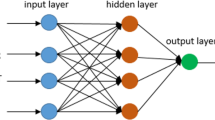Abstract
An efficient energy-aware clustering method helps in reducing the battery depletion of the different resources in WSNs. The selection of suitable sensors for cluster head can be an effective way to increase the proficiency of the clustering process. In the past two decades, a number of clustering methods have been proposed. However, most of the methods are suffering from the uneven variation in the number of the Cluster Head (CH), irregular energy consumption by the nodes, transmission of the redundant data, and unequal load of the cluster heads. This paper resolves these problems by proposing an energy-aware data gathering technique based on nature-inspired optimization for both homogeneous and heterogeneous networks. It considers a fitness function by integrating four fitness parameters namely: energy efficiency, cluster node density, average distance of sensors to the CH, and distance from CH to Base Station (BS). This method considers a chain based data gathering and transmission process for intra and inter-cluster communication. A data aggregation process is also introduced for removing the redundant data which helps in decreasing the transmission cost and overhead of the networks. The performance of the proposed methods is evaluated against the state of the art protocols by considering the different performance matrices like network lifetime in terms of rounds, stability period in terms of first node dead, total energy consumption per round, throughput, number of CHs per round etc. The experimental results show the network lifetime and throughput of the proposed method are increased by 23.14%, 29.42%, 60.48%, & 80.16%, and 38.38%, 40.06%, 71.88%, & 95.58%, in respect of the Senthil and Kannapiran method (Wirel Pers Commun 94(4):2239–2258, 2017), ICSCA (Gupta, Procedia Comput Sci 125:234–240, 2018), Adnan et al. method (Lect Note Electric Eng 362: 621–634, 2016), DEEC (Qing et al., Comput Commun 29(12):2230–2237, 2016), respectively, for 100 J network energy in case of tier-3 heterogeneity, respectively.













Similar content being viewed by others
References
Chand S, Singh S, Kumar B (2014) Heterogeneous HEED protocol for wireless sensor networks. Wirel Pers Commun 77(3):2117–2139
Singh S, Chand S, Kumar R, Malik A, Kumar B (2016) NEECP: novel energy-efficient clustering protocol for prolonging lifetime of WSNs. IET Wireless Sens Syst 6(5):151–157
Singh S, Malik A (2017) hetSEP: Heterogeneous SEP protocol for increasing lifetime in WSNs. J Inf Optim Sci 38(5):721–743
Heinzelman WR, Chandrakasan AP, Balakrishnan H (2002) An application-specific protocol architecture for wireless microsensor networks. IEEE Trans Wirel Commun 1(4):660–670
Lindsey S, Raghavendra CS, Sivalingam KM (2002) Data gathering algorithms in sensor networks using energy metrics. IEEE Trans Parallel Distrib Syst 13(9):924–935
Qing L, Zhu Q, Wang M (2016) Design of a distributed energy-efficient clustering algorithm for heterogeneous wireless sensor networks. Comput Commun 29(12):2230–2237
Singh S, Malik A, Kumar R (2017) Energy efficient heterogeneous DEEC protocol for enhancing lifetime in WSNs. Eng Sci Technol 20(1):345–353
Maheswari DU, Sudha S (2018) Node degree based energy efficient two-level clustering for wireless sensor networks. Wirel Pers Commun 104(3):1209–1225
Istwal Y, Verma SK (2019) Dual cluster head routing protocol with super node in WSN. Wirel Pers Commun 104(2):561–575
Singh S, Chand S, Kumar B (2017) Multilevel heterogeneous network model for wireless sensor networks. Telecommun Syst 64(2):259–277
Singh S, Chand S, Kumar B (2017) Energy-efficient protocols using fuzzy logic for heterogeneous WSNs. Wirel Pers Commun 86(2):451–475
Su S, Zhao S (2018) An optimal clustering mechanism based on fuzzy-C means for wireless sensor networks. Sustain Comput 18:127–134
Sodairi SA, Ouni R (2018) Reliable and energy-efficient multi-hop LEACH-based clustering protocol for wireless sensor networks. Sustain Comput Inform Syst 20:1–13
Narendran M, Prakasam P (2017) An energy aware competition based clustering for cluster head selection in wireless sensor network with mobility. Clust Comput 22:11019–11028. https://doi.org/10.1007/s10586-017-1286-5
Ke W, Yangrui O, Hong J, Heli Z, Xi L (2016) Energy aware hierarchical cluster-based routing protocol for WSNs. J China Univ Posts Telecommun 23(4):46–52
Yang XS, Deb S (2009) Cuckoo search via Levy flights. In: IEEE World Congress on Nature and Biologically Inspired Computing, pp. 210–214
Saida IB, Nadjet K, Omar B (2014) A new algorithm for data clustering based on cuckoo search optimization. Genet Evol Comput Adva Intell Syst Comput 238:55–64
Ameryan M, Akbarzadeh Totonchi MR, Seyyed Mahdavi SJ (2014) Clustering based on Cuckoo Optimization Algorithm. Iranian Conference on Intelligent Systems (ICIS), Bam, pp 1–6
Amiri E, Mahmoudi S (2016) Efficient protocol for data clustering by fuzzy cuckoo optimization algorithm. Appl Soft Comput 41:15–21
Adnan MA, Razzaque MA, Abedin MA, Salim Reza SM, Hussein MR (2016) A Novel Cuckoo Search Based Clustering Algorithm for Wireless Sensor Networks. Advanced Computer and Communication Engineering Technology. Lect Note Electric Eng 362:621–634
Gupta GP (2018) Improved cuckoo search-based clustering protocol for wireless sensor networks. Procedia Comput Sci 125:234–240
Senthil T, Kannapiran B (2017) ECTMRA: energy conserving trustworthy multipath routing algorithm based on cuckoo search algorithm. Wirel Pers Commun 94(4):2239–2258
Zhao J, Lei X, Wu Z, Tan Y (2014) Clustering using improved cuckoo search algorithm, advances in swarm intelligence, ICSI 2014. Lect Notes Comput Sci 8794:479–488
Bouyer A, Hatamlou A (2018) An efficient hybrid clustering method based on improved cuckoo optimization and modified particle swarm optimization algorithms. Appl Soft Comput 67:172–182
Author information
Authors and Affiliations
Corresponding author
Additional information
Publisher’s note
Springer Nature remains neutral with regard to jurisdictional claims in published maps and institutional affiliations.
Rights and permissions
About this article
Cite this article
Singh, S. An energy aware clustering and data gathering technique based on nature inspired optimization in WSNs. Peer-to-Peer Netw. Appl. 13, 1357–1374 (2020). https://doi.org/10.1007/s12083-020-00890-w
Received:
Accepted:
Published:
Issue Date:
DOI: https://doi.org/10.1007/s12083-020-00890-w




